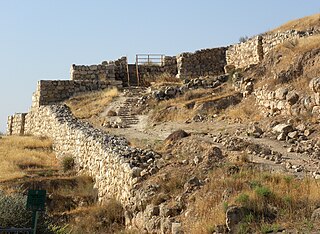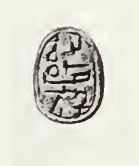
Lachish was an ancient Israelite city in the Shephelah region of Canaan on the south bank of the Lakhish River mentioned several times in the Hebrew Bible. The current tell by that name, known as Tel Lachish or Tell el-Duweir, has been identified with Lachish. Today, it is an Israeli national park operated and maintained by the Israel Nature and Parks Authority. It lies near the present-day moshav of Lakhish, which was named in honor of the ancient city.

Sir William Matthew Flinders Petrie, commonly known as simply Sir Flinders Petrie, was a British Egyptologist and a pioneer of systematic methodology in archaeology and the preservation of artefacts. He held the first chair of Egyptology in the United Kingdom, and excavated many of the most important archaeological sites in Egypt in conjunction with his wife, Hilda Urlin. Some consider his most famous discovery to be that of the Merneptah Stele, an opinion with which Petrie himself concurred. Undoubtedly at least as important is his 1905 discovery and correct identification of the character of the Proto-Sinaitic script, the ancestor of almost all alphabetic scripts.
The year 1999 in archaeology involved some significant events.

Sharuhen was an ancient town in the Negev Desert or perhaps in Gaza. Following the expulsion of the Hyksos from Egypt in the second half of the 16th century BCE, they fled to Sharuhen and fortified it. The armies of Pharaoh Ahmose I seized and razed the town after a three-year siege.

'Ammu Aahotepre was a pharaoh of the 14th Dynasty who ruled over parts of Egypt during the Second Intermediate Period. His reign is believed to have lasted about 15 years, from 1760 BC until 1745 BC.

Wadi Gaza and Besor Stream are parts of a river system in the Gaza Strip and Negev region of Palestine and Israel. Wadi Gaza is a wadi that divides the northern and southern ends of the Gaza Strip, its major tributary is Besor Steam. In 2022 work began to rehabilitate Wadi Gaza Nature Reserve.

Pottery and ceramics have been produced in the Levant since prehistoric times.

Philistine Bichrome ware is an archaeological term coined by William F. Albright in 1924 which describes pottery production in a general region associated with the Philistine settlements during the Iron Age I period in ancient Canaan. The connection of the pottery type to the "Philistines" is still held by many scholars, although some question its methodological validity.

Tell es-Sakan is a tell about 5 km south of Gaza City in what is today the Gaza Strip, on the northern bank of Wadi Ghazzeh. It was the site of two separate Early Bronze Age urban settlements: an earlier one representing the fortified administrative center of the Egyptian colonies in southwestern Palestine from the end of the 4th millennium, and a later, local Canaanite fortified city of the third millennium. The location at the mouth of what was probably a palaeochannel of the river, allowed it to develop as an important maritime settlement with a natural harbour. Its geographical location endowed it with a position of importance at the crossroads of land-based trade routes between the Canaan region, the Old Kingdom of Egypt, and Arabia. As of 2000, the early Egyptian settlement was the oldest fortified site known to researchers in both Egypt and Palestine.
Peter M. Fischer is an Austrian-Swedish archaeologist. He is a specialist on Eastern Mediterranean and Near Eastern archaeology, and archaeometry. He belongs to the University of Gothenburg and is associated with the Austrian Academy of Sciences, Sweden. He is the founder and director of the Swedish Jordan Expedition, the Palestinian-Swedish Expedition at Tall al-Ajjul, Gaza. He became the director of the Swedish Cyprus Expedition in 2009 and carried out excavations at Hala Sultan Tekke since 2010. He is member/corresponding member of The Royal Society of Arts and Sciences in Gothenburg, Royal Swedish Academy of Letters, History and Antiquities. and The Austrian Academy of Sciences.

Chocolate-on-White ware is the description commonly given to an important diagnostic ceramic type of Bronze Age Southern Levant. It is characterized by a white slip and dark-brown or black decorations on it. Often it is also classified as bichrome decorated pottery ware, although it also sometimes comes in monochrome variety.

Tell el-Yahudiyeh Ware or Tell el-Yahudiya ware is a distinctive ceramic ware of the late Middle Bronze Age/Second Intermediate Period. The ware takes its name from its type site at Tell el-Yahudiyeh in the eastern Nile Delta of ancient Egypt, and is also found in a large number of Levantine and Cypriot sites. It was first recognised as a distinctive ware by Sir Flinders Petrie during his excavation of the type site.

Hilda Mary Isabel, Lady Petrie, was an Irish-born British Egyptologist and wife of Sir Flinders Petrie, the father of scientific archaeology. Having studied geology, she was hired by Flinders Petrie at age 25 as an artist, which led to their marriage and a working partnership that endured for their lifetimes.

Cypriot Bichrome ware is a type of Late Bronze Age, and Iron Age, pottery that is found widely on Cyprus and in the Eastern Mediterranean. This type of pottery is found in many sites on Cyprus, in the Levant, and also in Egypt. It was typically produced on a pottery wheel. A large variety of decorations and motifs are attested. This pottery is very similar to certain types of the Mycenaean pottery from various locations.

Sekhaenre Yakbim or Yakbmu was a ruler during the Second Intermediate Period of Egypt. Although his dynastic and temporal collocation is disputed, Danish Egyptologist Kim Ryholt believes that he likely was the founder of the Levantine-blooded Fourteenth Dynasty, while in older literature he was mainly considered a member of the Sixteenth Dynasty.

The Tell el-Ajjul gold hoards are a collection of three hoards of Bronze Age gold jewellery found at the Canaanite site of Tell el-Ajjul in Gaza. Excavated by the British archaeologist Flinders Petrie in the 1930s, the collection is now mostly preserved at the British Museum in London and the Rockefeller Museum in Jerusalem. The treasure ranks amongst the greatest Bronze Age finds in the Levant.

Olga Tufnell was a British archaeologist who assisted on the excavation of the ancient city of Lachish in the 1930s. She had no formal training in archaeology, but had worked as a secretary for Flinders Petrie for a number of years before being given a field assignment. Olga then went on to join James Leslie Starkey in the expedition to find Lachish in 1929 and remained part of the team for the following seasons.

Tell Jemmeh or Tell Gemmeh, also known in Hebrew as Tel Gamma or Tel Re'im, is a prominent mound, or tell, located in the region of the northwestern Negev and the southern coastal plain of Israel, about 12 km south of Gaza, bounded by the kibbutz of Re'im 2 km to the east, and the kibbutz of Kisufim 6 km to the west, and is 9 km east of the Mediterranean coast. The site is located at the confluence of two streams, Nahal Besor and Nahal Gerar. Both have changed their course in this area many times throughout history.
Tell el-Far'ah (South) is an archaeological site on the bank of HaBesor Stream in the northern Negev region, Israel. Not to be confused with the site Tell el-Far'ah (North). It is located between the modern settlements of Ein HaBesor and Urim, some 12 kilometres (7.5 mi) from the modern city of Ofakim and 20 kilometres (12 mi) from Gaza.
Moain Sadeq is a Palestinian-Canadian archaeologist specialising in the archaeology of Gaza. He teaches at Qatar University and has worked at colleges in Canada. After completing a doctorate at the Free University of Berlin, Sadeq co-founded the Faculty of Education in Gaza, which later became Al-Aqsa University. In 1994, Sadeq co-founded the Department of Antiquities of Gaza. While working at department, Sadeq jointly led excavations at Tell es-Sakan and Tell el-‘Ajjul.


















